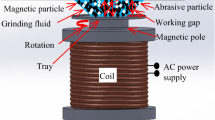Abstract
A magnetic abrasive nano-polishing process using low-frequency alternating magnetic field was developed for micro-grooves surface in this study. And by using alternating magnetic force produced by low-frequency (3 Hz) alternating magnetic field to make magnetic cluster generates a cyclical fluctuation of up and down, and then promotes the abrasives into micro-groove surface. A set of experimental devices were designed to investigate the effect of magnetic pole shape on magnetic field distribution and finishing characteristics. Final experiments were performed on glass and alloy steel specimens to examine the polishing performance for micro-groove surface. The glass initial surface roughness (Ra) of 123.38 nm, 130.71 nm, 136.08 nm, and 129.39 nm decreased respectively to 55.18 nm, 50.92 nm, 65.62 nm, and 62.42 nm and the groove surfaces obtained obvious improvement by this process. The surface roughness (Ra) of alloy steel is reduced as low as 68.70 nm from 192.48 nm, and the burr of edge and groove surface was removed effectively after 20-min polishing. It is demonstrated that this process is effective for deburring and improving micro-groove surface quality.















Similar content being viewed by others
References
Zhang YX, Kang RK, Guo DM, Guo D, Jin ZJ (2007) Microstructure studies of the grinding damage in monocrystalline silicon wafers. Rare Metals 26(1):13–18
Xie J, Luo M, Wu K, Yang L, Li D (2013) Experimental study on cutting temperature and cutting force in dry turning of titanium alloy using a non-coated micro-grooved tool. Int J Mach Tool Manuf 73:25–36
Mo JL, Wang JG, Chen GX, Shao TM, Zhu MH, Zhou ZR (2013) The effect of groove-textured surface on friction and wear and friction-induced vibration and noise. Wear 301(s 1–2):671–681
Abou Ziki JD, Didar TF, Wüthrich R (2012) Micro-texturing channel surfaces on glass with spark assisted chemical engraving. Int J Mach Tool Manuf 57:66–72
Falconnet D, Csucs G, Grandin HM, Textor M (2006) Surface engineering approaches to micropattern surfaces for cell-based assays. Biomaterials 27:3044–3063
Yun H, Han B, Chen Y, Liao M (2016) Internal finishing process of alumina ceramic tubes by ultrasonic-assisted magnetic abrasive finishing. Int J Adv Manuf Tech 85(1-4):727–734
Kajal S, Jain VK, Ramkumar J, Nagdeve L (2017) Experimental and theoretical investigations into internal magnetic abrasive finishing of a revolver barrel. Int J Adv Manuf Tech 100(5-8):1105–1122
Yoon S, Tu JF, Lee JH, Yang GE, Mun SD (2014) Effect of the magnetic pole arrangement on the surface roughness of STS 304 by magnetic abrasive machining. Int J Precis Eng Manuf 15(7):1275–1281
Choopani Y, Razfar MR, Saraeian P, Farahnakian M (2016) Experimental investigation of external surface finishing of AISI 440C stainless steel cylinders using the magnetic abrasive finishing process. Int J Adv Manuf Tech 83(9-12):1811–1821
Heng LD, Yang GE, Wang R, Kim MS, Mun SD (2015) Effect of carbon nano tube (CNT) particles in magnetic abrasive finishing of Mg alloy bars. J Mech Sci Tech 29(12):5325–5333
Sun X, Zou YH (2017) Development of magnetic abrasive finishing combined with electrolytic process for finishing SUS304 stainless steel plane. Int J Adv Manuf Tech 92:3373–3384
Wang R, J Park H, Heng LD, Kim Y, Jeong Y, Mun SD (2018) Effect of temperature on the magnetic abrasive finishing process of Mg alloy bars. J Mech Sci Tech 32(5):2227–2235
Lee YH, Wu KL, Bai CT, Liao CY, Yan BH (2015) Planetary motion combined with two-dimensional vibration-assisted magnetic abrasive finishing. Int J Adv Manuf Tech 76(9-12):1865–1877
Du ZW, Chen Y, Zhou K, Li C (2015) Research on the electrolytic-magnetic abrasive finishing of nickel-based superalloy GH4169. Int J Adv Manuf Tech 81(5-8):897–903
Zhou K, Chen Y, Du ZW, Niu FL (2015) Surface integrity of titanium part by ultrasonic magnetic abrasive finishing. Int J Adv Manuf Tech 80(5-8):997–1005
Lin CT, Yang LD, Chow HM (2007) Study of magnetic abrasive finishing in free-form surface operations using the Taguchi method. Int J Adv Manuf Tech 34(1-2):122–130
Guo J, Tan ZEE, Au KH, Liu K (2016) Experimental investigation into the effect of abrasive and force conditions in magnetic field-assisted finishing. Int J Adv Manuf Tech 90(5-8):1881–1888
Wu JZ, Zou YH, Sugiyama H (2015) Study on ultra-precision magnetic abrasive finishing process using low frequency alternating magnetic field. J Mag Mag Mater 386:50–59
Wu JZ, Zou YH, Sugiyama H (2015) Study on finishing characteristics of magnetic abrasive finishing process using low-frequency alternating magnetic field. Int J Adv Manuf Tech 85(1-4):585–594
Zou YH, Xie HJ, Dong CW, Wu JZ (2018) Study on complex micro surface finishing of alumina ceramic by the magnetic abrasive finishing process using alternating magnetic field. Int J Adv Manuf Tech 97(5-8):2193–2202
Wang YQ, Yin SH, Huang H (2017) A comparative study on magnetorheological planarization using modified magnetic yokes and brick magnet. Int J Adv Manuf Tech 91(5-8):2831–2841
Author information
Authors and Affiliations
Corresponding author
Additional information
Publisher’s note
Springer Nature remains neutral with regard to jurisdictional claims in published maps and institutional affiliations.
Rights and permissions
About this article
Cite this article
Wu, J., Yin, S., Xing, B. et al. Effect of magnetic pole on finishing characteristics in low-frequency alternating magnetic field for micro-groove surface. Int J Adv Manuf Technol 104, 4745–4755 (2019). https://doi.org/10.1007/s00170-019-04362-1
Received:
Accepted:
Published:
Issue Date:
DOI: https://doi.org/10.1007/s00170-019-04362-1



